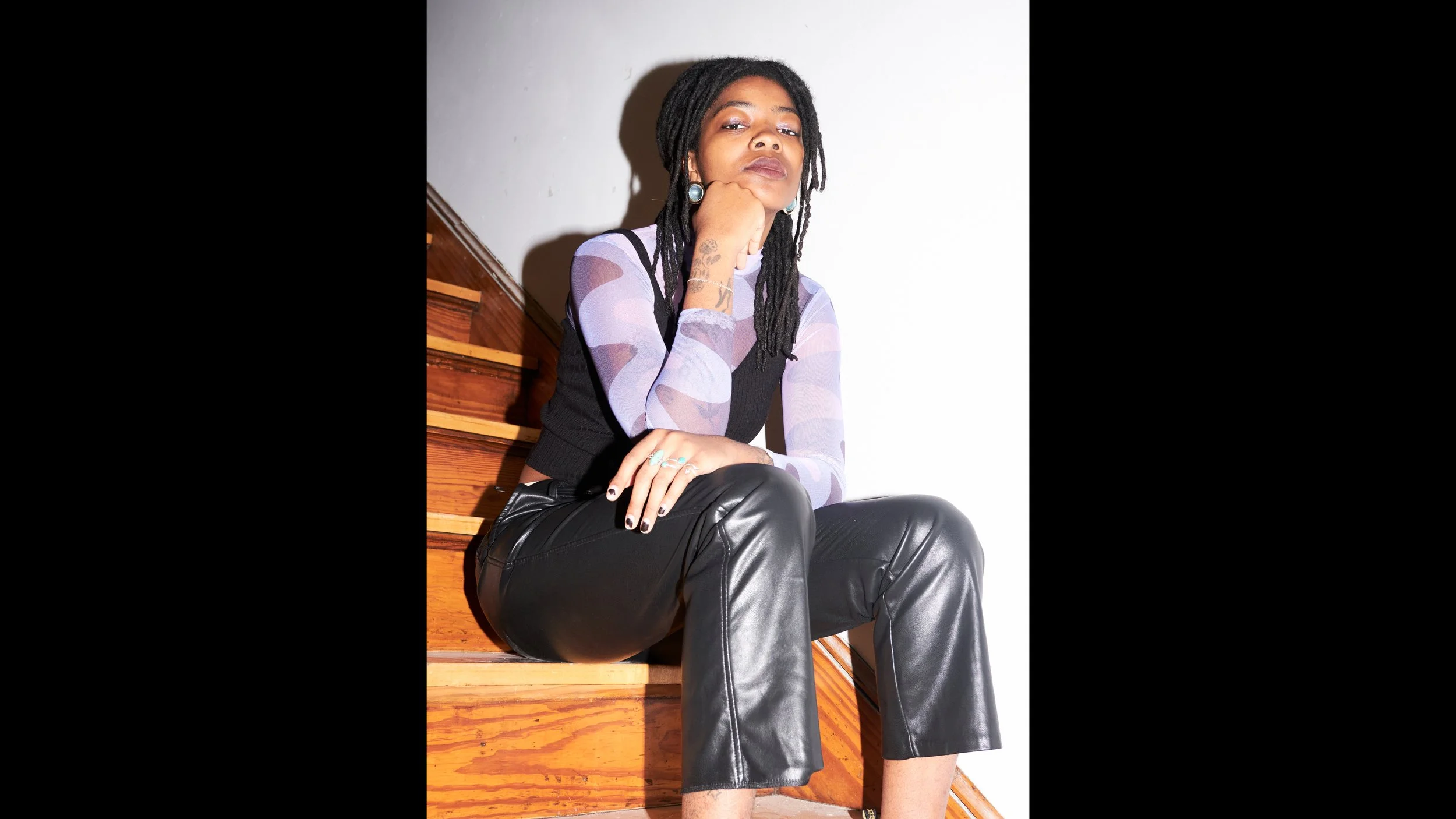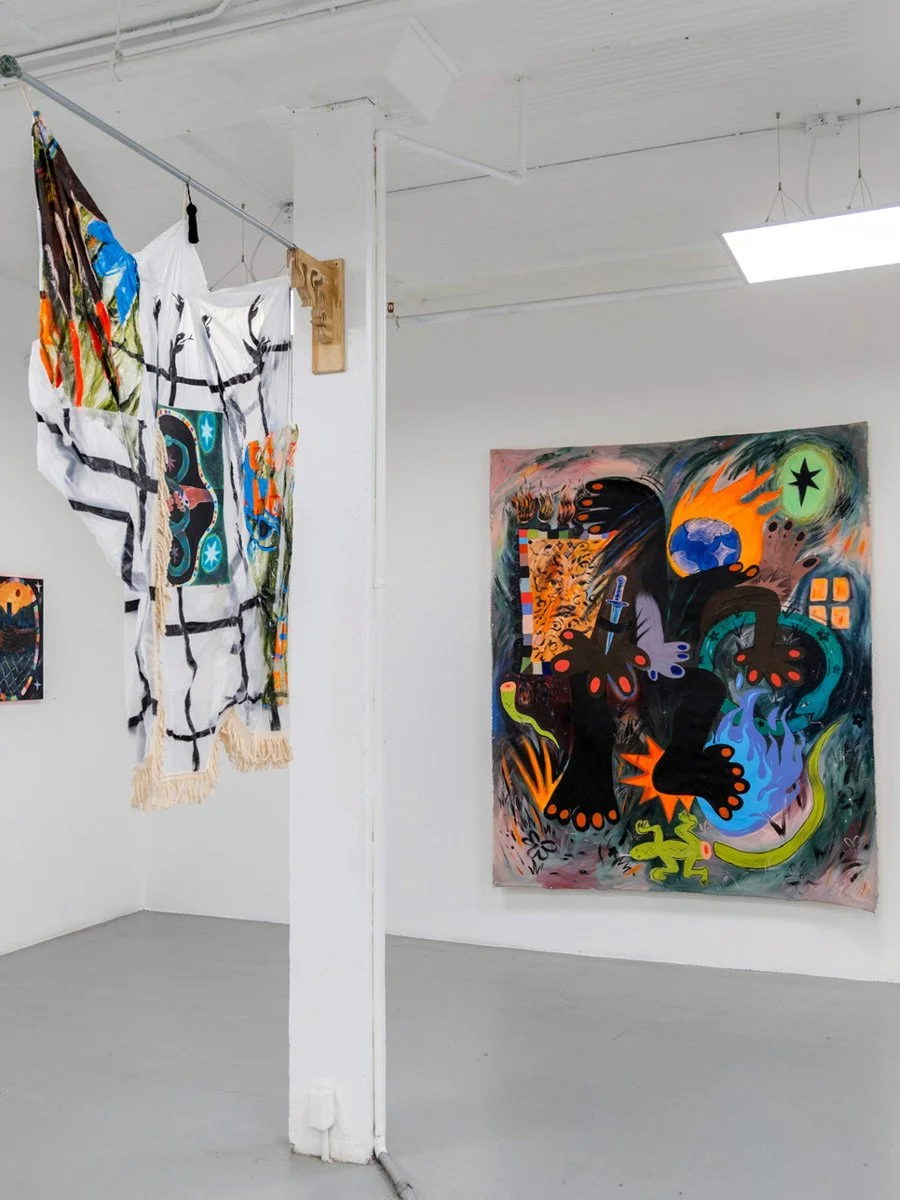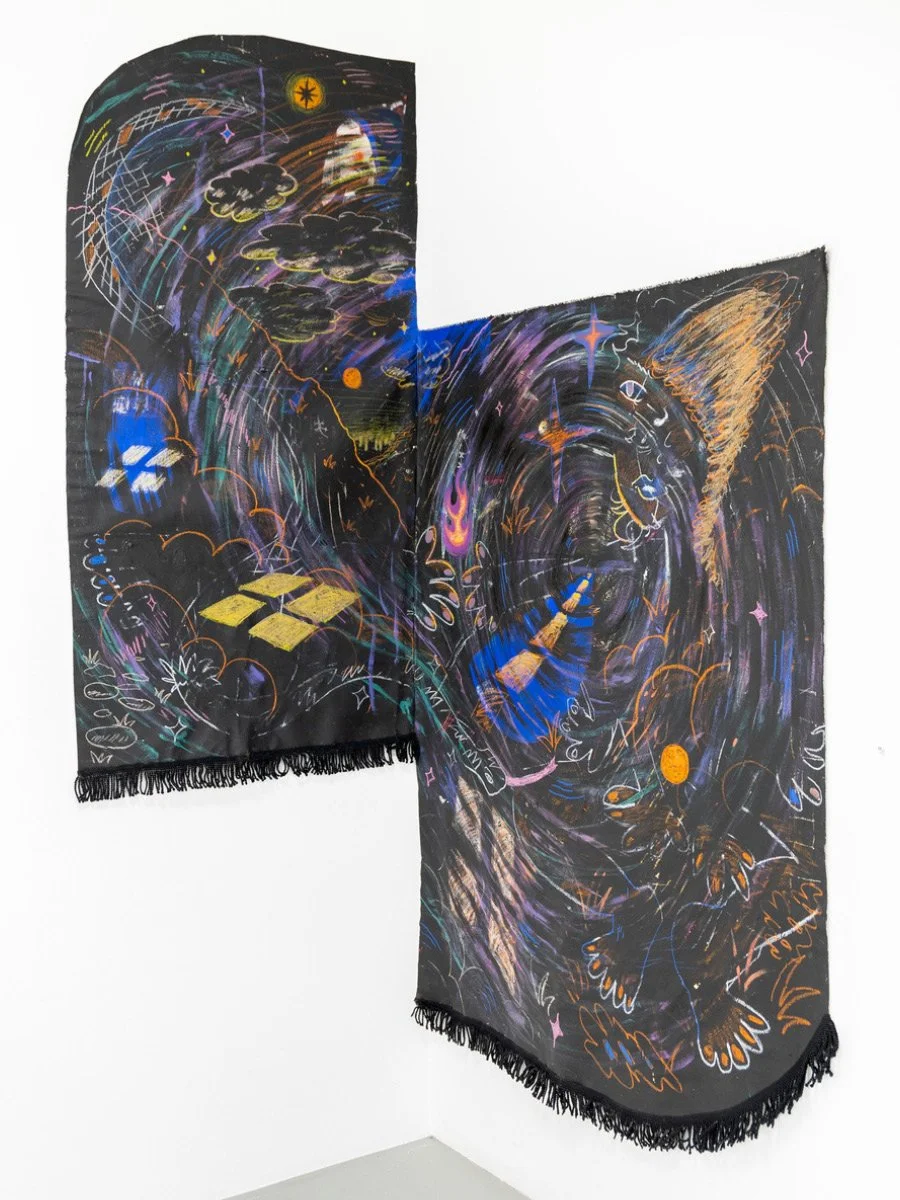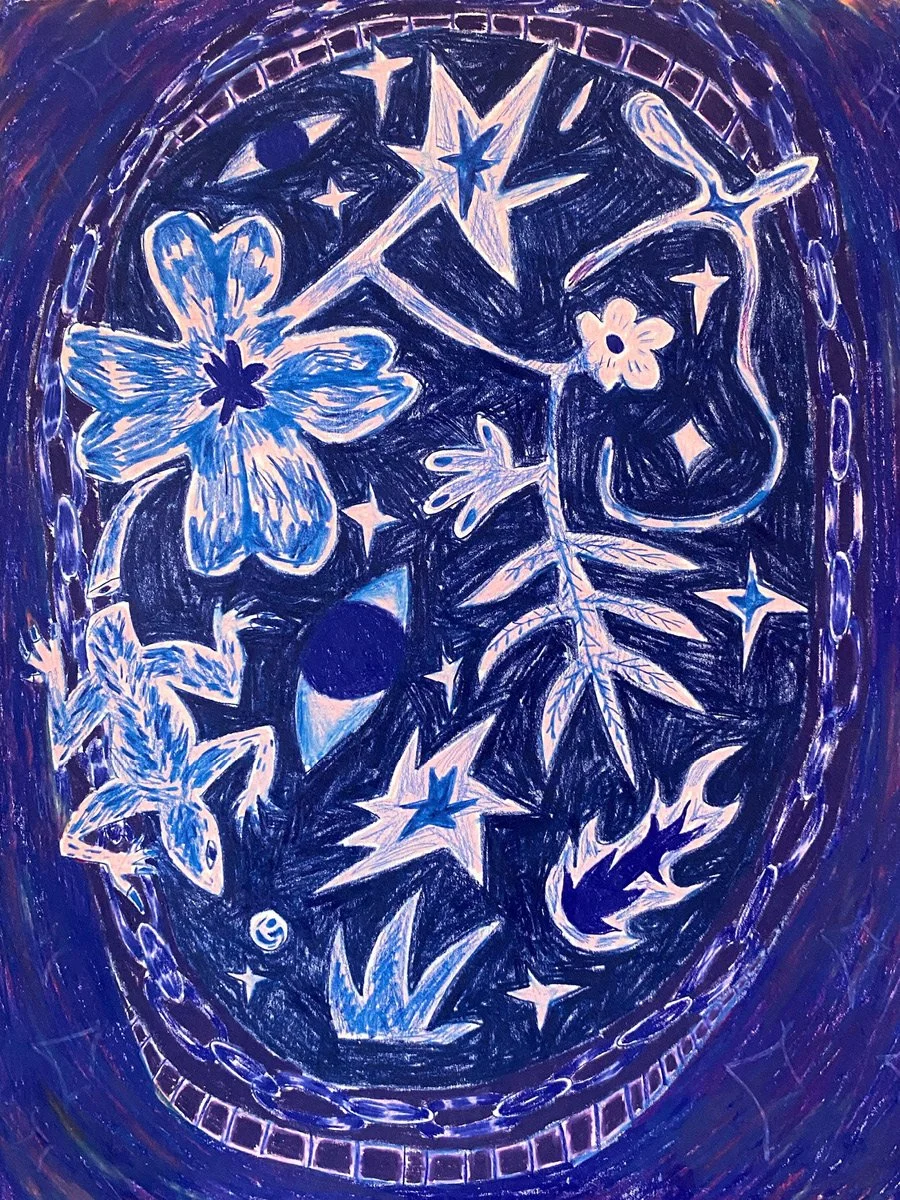GROWING NEW TALES
Interviewed Mar 2025. Photos courtesy of Hawthorn Contemporary & James Kramer.
Phoenix welcomed us to her solo exhibition And All I Know Has Vanished Again at Hawthorn Contemporary in Milwaukee. We discussed her creative process, the symbolism behind her motifs, and her evolving relationship with nighttime. Her work blends the personal and universal, using abstract forms to explore transformation, healing, and reclaiming space. Drawing from her upbringing in Cincinnati, her art reflects a dialogue between the urban and natural worlds, with motifs like lizards, flowers, and tornadoes symbolizing rebirth and emotional tension. Influenced by cartoons and her time in both the Midwest and Appalachia, her figures balance abstraction and representation. With an Aquarius Sun, Cancer Moon, and Pisces Rising, Phoenix approaches the world like she does her art—intuitively, emotionally attuned, and guided by an internal, nonlinear logic.
TRIPLE3: How did your upbringing in an urban environment influence the motifs you explore in your work?
PHOENIX BROWN: Growing up in an urban setting, many of the motifs in my work originate from places I used to visit as a child. Cincinnati is historic, older than Milwaukee, so there are subtle references to architecture that appear in my work. That’s where things like bricks, skylines, and fences come from. And the lizards, too, there are these little freaky lizards down there that are actually an invasive species. So, when I think about the hills, the valley, and the mix of urban and natural elements, my work ultimately becomes a collage of those overlapping environments. The Ohio River Valley sits on the cusp of the Midwest and Appalachia, and because of the rolling hills, I never really saw the sun meet the land. It would always rise and set behind the hills. So when I moved up to Milwaukee and saw the sun meet the water on the lake, especially during a moonrise, it felt surreal, like, what is happening? I’d never seen that before. Capturing that kind of personal awe through abstraction and symbolism is something I strive for in painting, and I’m relieved I haven’t achieved it yet. There’s so much more discovery I get to pursue through the medium by witnessing my surroundings (hopefully for a lifetime).
3: You talk about nighttime a lot in your work and your relationship changes from this fear to this empowering time of day. Do you want to talk about why you’re interested in exploring that?
P: For sure, it stems from my childhood. I was taught that nighttime was something to avoid being caught in. My family was also very protective of my sister and me. At one point, to keep us safe, we weren’t allowed to go past the mailbox. But it’s funny to describe, because our house was set back far from the street, tucked into the woods, and you have to go up a long driveway just to reach it. So we had space to play, they just didn’t want us going down to the road where they couldn’t see us. Even as I got older, I had to be home before the streetlights came on, regardless of whether it was still light outside (that was hard when my friends were still hanging out). This all set a baseline fear of the dark for me. I was told again and again that nothing good ever happens in it, especially if you’re a girl and alone. But now I’m trying to unlearn that fear. These days, I live alone, and I often have to walk at night or come home late from hanging out with friends. I’ve had to learn to navigate the dark on my own. And honestly, that’s been really empowering. I’ve started to feel more agency in that space.
After the Funeral (2022) Color pencil on paper, 12 x 9 in
Until I’m Resting Here With Me (2025) Acrylic, oil pastel, and polyester on canvas, 95” x 105”
And All I Know Has Vanished Again (2025), Hawthorn Contemporary, Milwaukee, WI, March 1–April 19
Midnight Mirror (2024) Colored pencil on paper, 14” x 11”
3: This ties perfectly into the next question, because I feel like your street mural is so vibrant and cute. Do you want to talk about this new street mural that you did? How was this experience, and how does it differ from the work we’re seeing in this room right now?
P: Yeah, it was such a lovely experience. The mural was coordinated through Luna, a Milwaukee-based, Lantinx-run business that develops creative projects on behalf of clients and organizations. I was commissioned to design a piece inspired by the interests of students at Milwaukee High School of the Arts. I couldn’t meet with them in person due to scheduling conflicts, but the project coordinator gathered input by asking the students what they’d like to see in their neighborhood. Their answers were so fun. Some mentioned games and play, and one student was really into chess. I ended up including a checkerboard pattern as a nod to that. Others wanted to see more representation of Hmong culture. I conducted research in the neighborhood and incorporated patterns inspired by Hmong story cloths, triangles for mountains and journeys, and a swirled heart for love and unity. A few students also said they loved nails, so I threw in a full set of acrylics in the design too. When it came time to paint, the community really came together. It was mostly me, Luna, Near Westside Partners staff, and volunteers who finished the mural, but neighbors would stop by, grab a brush, and join in. It was super hot out, but overall just a beautiful and collaborative experience.
3: These metaphors through your work, such as, flowers, fires, reptiles, and even tornadoes. How do you choose these figures?
P: That’s a good question. Many of the symbols I use began to appear intuitively. I’d paint the same thing over and over before realizing what it meant to me. It’s as if I had to let the work speak for itself, rather than deciding everything up front. For example, reptiles represent rebirth to me. I was fascinated by the idea of lizards dropping their tails. Sometimes they grow back, sometimes not, but I like imagining those tails having autonomy, still wiggling like they’re alive. Snakes are similar; I love how they shed their skin and keep moving, constantly transforming. Flowers, on the other hand, can represent innocence or the act of being resilient. Tornadoes are one of the few symbols in my work that carry more chaotic or negative energy, though even then, it’s more about emotional tension, things being wound up and spinning out. Kind of like in tarot, where destruction isn’t necessarily bad, it just means change is imminent, whether or not we like the mode of its arrival.
3: What’s your favorite reptile?
P: Oh, definitely those silly Lazarus lizards I mentioned earlier. They came over from Italy in the ’50s when a department store owner’s kid smuggled them in his socks and turned them loose into the wild. Now they’ve been multiplying for like 70 years. I read about them online after years of curiosity, Ohio State has a whole research page on them. I used to see them around town during the summers. It’s pretty insane, but letting myself be swept up by an idea or an odd story always leads to something fruitful in the end.
Read more about Phoenix Brown in Triple Issue 2





